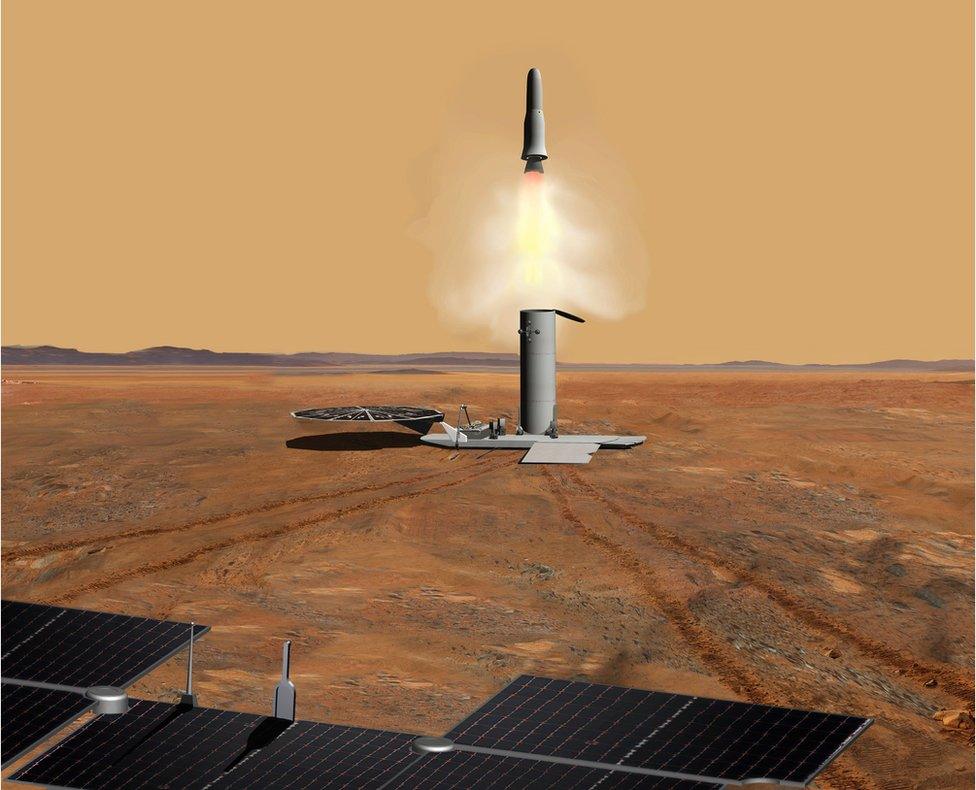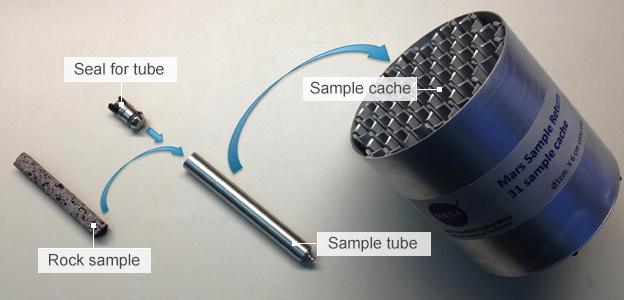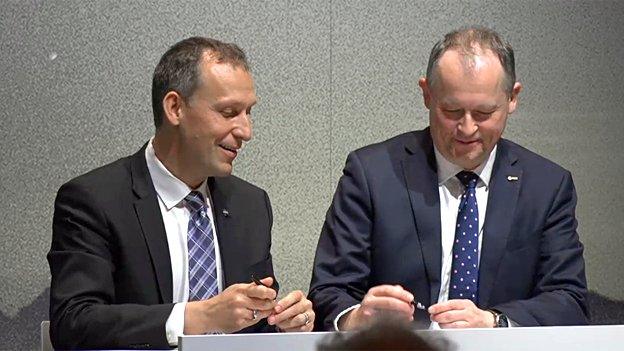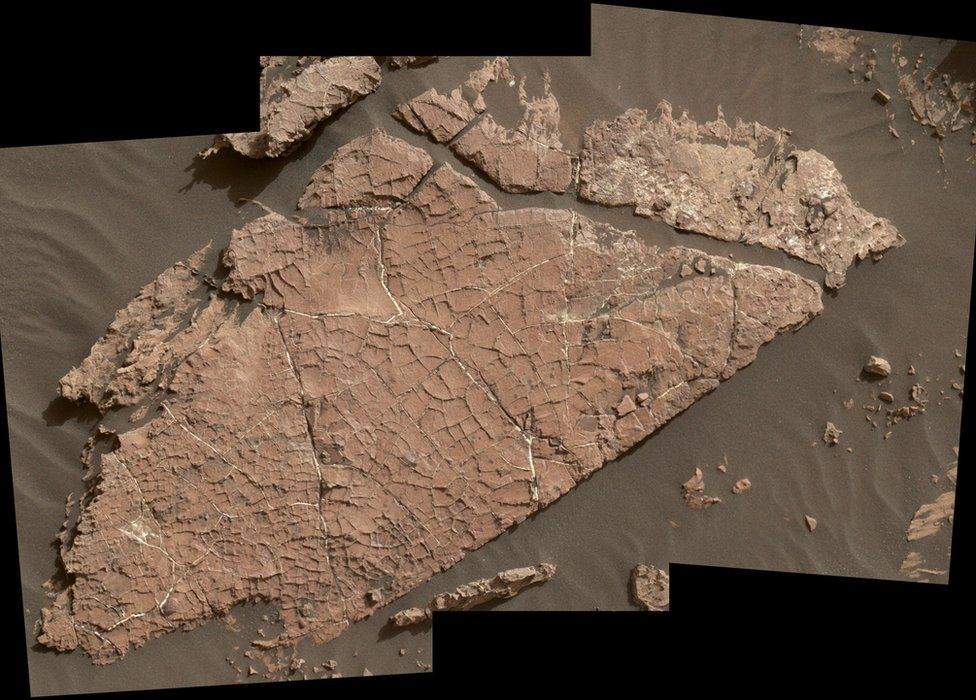Space agencies aim to deliver rocks from Mars to Earth
- Published
- comments

Artwork: The mission would allow Martian rock and soil samples to be studied in labs on Earth
The US and European space agencies are edging towards a joint mission to bring back rock and soil samples from Mars.
Nasa and Esa have signed a letter of intent that could lead to the first "round trip" to another planet.
The move was announced as a meeting in Berlin, Germany, discussed the science goals and feasibility of a Mars Sample Return (MSR) mission.
The venture would allow scientists to answer key questions about Martian history.
Those questions include whether the Red Planet once hosted life.
Scientists at the Mars meeting said that there was only so much they could learn from Martian meteorites and from the various rovers and static landers sent to the Red Planet.
The next step had to be a mission that would retrieve samples from the Martian surface, blast them into space in a capsule and land them safely on Earth.

Artwork: Nasa is sending a rover to Mars in 2020 that will select and cache samples
They could then be subjected to detailed analysis in laboratories, using instruments that are too big and power-hungry to carry as part of a robotic rover's payload and techniques that are difficult to perform from 55 million kilometres away.
Making the announcement at the ILA Berlin Air and Space Show, external, which is taking place at the same time as the Mars science meeting, Dr Thomas Zurbuchen, Nasa's associate administrator for science, said: "We want to partner with the European Space Agency, but also with other partners."
He said this included potential link-ups with the commercial space sector, adding: "We will at every point look at what is available in the commercial market. Nasa has no interest whatsoever in developing things that we can buy."
Dave Parker, director of human and robotic exploration at Esa, commented: "It's very important that every mission we send to Mars discovers something slightly unusual. It's on the basis of that that we tend to plan the next mission or next missions."

Even a small collection of material would help transform our understanding
Nasa's 2020 rover mission is expected to help pave the way for Mars Sample Return, by drilling into the surface and caching the cores in containers. But this is intended as a demonstration.
A mission design would need to be drawn up in coming years. Previous sample return concepts envisaged a rover storing geological samples from scientifically desirable locations on Mars.
The cached samples would then be loaded on to an ascent vehicle which would lift off from the Martian surface. After the cruise back to Earth, a descent module would parachute down through Earth's atmosphere, delivering the first retrieved Martian samples directly into the hands of experts waiting on the ground.
Dr Caroline Smith, head of Earth sciences collections at London's Natural History Museum, is attending the Berlin meeting. "I would say it's a reinvigoration of the process," she told BBC News.
"Numerous studies have said the only way it's going to be achieved is through international co-operation. So I think this is a really good message from Nasa and Esa, that we are really going to work together to achieve this - the next frontier of exploration of the Solar System."
She added: "There's a real buzz in the room. I've spoken to my colleagues and they've said: 'Wow, we're really going to do this'!"
Protecting the planet
If life existed in the past on the Red Planet, it would likely have been microbial in nature. Scientists want to first know whether conditions were right for life to get started in the past and, if so, whether evidence of fossil microbes remains. They also want to resolve whether there's life on the Red Planet now. "We'll only be able to conclusively answer those questions by bringing samples back," she explained.

Thomas Zurbuchen (L) and Dave Parker (R) signed the letter of intent in Berlin
The current high levels of cosmic radiation on Mars' surface - a consequence of its thin atmosphere - would create a hostile environment for any organisms. But there are ways life might be able to cling on. The possibility that organisms live in the Martian subsurface today means the mission would be subject to strict quarantine, or "planetary protection", measures.
"We have to be careful we're not contaminating Mars with material from our planet, and we want to make sure we're not accidentally contaminating the samples in a way that would interfere with experiments we want to do on Earth," explained Dr Smith. She added: "If there's something hazardous on Mars, we don't want to accidentally release that into Earth's biosphere.
"We are used to handling hazardous materials, whether they be biological or nuclear. There are technologies that exist to be able to handle these in a safe way."
Dr Zurbuchen said the sample return mission could also be crucial for later planned human exploration of Mars, which he said Nasa should start thinking about in the 2030s.
"I can imagine a lot of scenarios where the samples are actually critical for how we explore as humans," he said.

Korolev crater: TGO's first image since arriving in its science orbit at Mars
For example, scientists want to sample dust from both the atmosphere and soil, because it could have an important impact. If future human "bases" were to rely on solar cells, atmospheric dust might block out sunlight - hampering electricity generation.
It might also cause problems inside the crew habitats. Dr Smith commented: "If that dust is ubiquitous, and gets everywhere and you've got people living there who are breathing in the dust, is it going to be a potential hazard to astronauts?"
While rocks relevant to the life question are an obvious target for sample return, igneous rocks formed by magma from Mars' interior are also on the wish-list. "By collecting igneous rocks, we get to understand the geochemical evolution of the planet Mars, we get to know when lavas were being erupted," said Caroline Smith.
Analysis of these rocks could help provide a much more accurate chronology for the Red Planet, which currently relies in part on values worked out from studies of the Moon.
In 2009, Nasa and Esa agreed to collaborate on the Mars Joint Exploration Initiative, external, which would have culminated in the recovery of samples in the 2020s. But in 2011, Nasa cancelled its participation amid a budgetary squeeze.
The 2nd International Mars Sample Return Conference, external is taking place from 25-27 April 2018 in Berlin.
Follow Paul on Twitter., external

Mud cracks: Mars is dry today but it was once much wetter and warmer